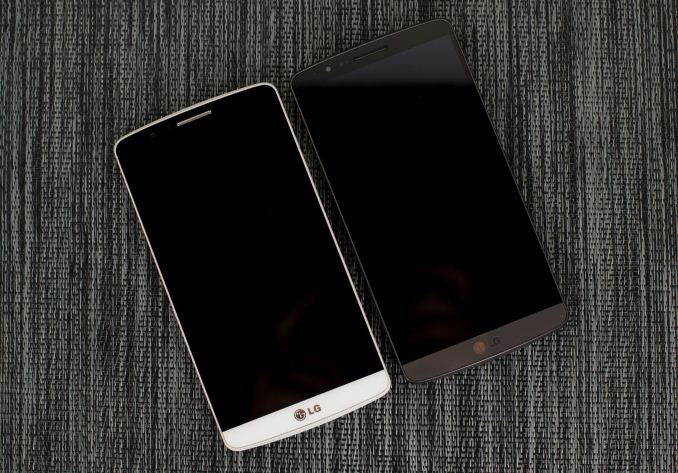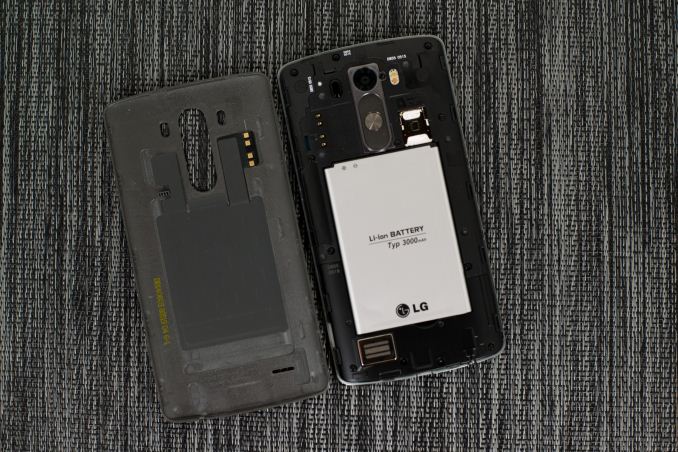The LG G3 Review
by Joshua Ho & Anand Lal Shimpi on July 4, 2014 5:00 AM EST- Posted in
- Smartphones
- LG
- Mobile
- Laptops
- G3

While the enthusiast segment is no stranger to LG smartphones, for the most part LG hasn’t received nearly the amount of attention that Samsung has. At first, it doesn’t make much sense. After all, LG is almost as big as Samsung. Both are chaebols, with enormous resources and power that few other companies have. Starting from the Optimus G, it seems that LG has shipped some of the best hardware in the industry, leveraging all the branches of the company from LG Innotek to LG Display to make a product that was easily equal to or better than the competition at the time.
One of the real issues that LG faced was a credibility gap. After the Optimus 2X and 4X HD, LG simply lacked credibility amongst the enthusiast audience. Without this audience and without the marketing push that other OEMs had, LG phones simply didn’t sell. Fortunately, things have gotten better since those days. The G2 brought significant attention to LG phones, and if anything, LG has been the sleeping giant in the industry. LG’s displays have been some of the best in the industry, and as an Android OEM they’ve consistently executed well on hardware. The immense popularity of the LG-made Nexus 4 and 5, even amongst mainstream consumers is surprising, especially because they were supposed to be developer devices.
Hardware
This leads us to the LG G3, which is now available in Korea and ready to be sold internationally. LG now faces the difficult task of succeeding the G2, one of the best phones of 2013. To find out whether they’ve made a worthy successor, we start with industrial and material design. When you first pick up the G3, it’s obvious that LG wanted to make a phone with the look and feel of brushed aluminum. To this end, LG has definitely done a good job. Although the polycarbonate back feels much warmer in the hand, the texture is good, and in practice even after extended use I never felt like the phone was grimy. It’s good to see that most of these OEMs are moving away from glossy finishes. The back cover is also removable, which allows for a removable battery and microSD slot. The front of the display is almost unchanged from last year, with extremely small bezels all around to reduce wasted space. The one change to the front of the phone is a band of color around the bottom that matches the color of the back.
Around the sides, the port layout remains nearly identical. The top has the IR Tx/Rx ports, the bottom has the 3.5mm jack and a microUSB port in the USB 2.0 shape. LG has also added a beveled edge from the display to the sides, which emphasizes the curved nature of the back. On the back of the phone, one can see the camera with the IR rangefinder and LED flash to the sides. The volume and power buttons are directly below the camera. The volume rocker is relatively flat compared to the protruding power button, which also has a noticeably different texture to distinguish the two from each other. The single, 1W speaker is towards the bottom.
Outside of these basic button and port placements, the hardware itself is high-end. The key differentiation points in this case are the camera system, QHD display, and the high-power speaker. I’ve put the rest of the basic specs in the table below.
| LG G3 | |
| SoC | MSM8974AC 2.45 GHz Snapdragon 801 |
| RAM/NAND | 3 GB LPDDR3, 32GB NAND + microSD |
| Display | 5.5” 1440p IPS LCD |
| Network | 2G / 3G / 4G LTE (Qualcomm MDM9x25 UE Category 4 LTE) |
| Dimensions | 146.3 x 74.6 x 8.9mm, 149 grams |
| Camera | 13MP rear camera, 1.12 µm pixels, 1/3.06" CMOS size, F/2.4. 2.1MP F/2.0 FFC |
| Battery | 3000 mAh (11.4 Whr) |
| OS | Android 4.4.2 with LG UI |
| Connectivity | 802.11a/b/g/n/ac + BT 4.0, USB2.0, GPS/GNSS, MHL, DLNA, NFC |
| SIM Size | MicroSIM |
While the spec sheet gives an idea of what to expect from the G3’s size, it’s surprisingly small for a 5.5” display size device. Unfortunately, this doesn’t make the G3 easy to use with one hand. While using the One (M8) and Galaxy S5 with one hand is uncomfortable, the G3 is almost impossible to use with one hand. Trying to tap something on the left side of the phone when using it with the right hand is difficult, and trying to reach for something on the top left of the display is almost impossible. While the division between phone and phablet is relatively clear in my mind, the G3 is in the line between both. I don’t object to the phablet formfactor, but this is supposed to be a phone, not a phablet. In addition, because the G3 has such thin bezels, it's very easy to accidentally activate the touch panel unintentionally while trying to stretch for one area of the display.
Other than the size, I definitely like what LG has done here. The design of the phone is understated and classy, even if it’s a bit off-putting that LG is trying to make plastic feel like metal. The back buttons are a non-issue, even without KnockOn/Off and KnockCode, and the curved back is great for ergonomics. However, I question the wisdom of moving to a removable battery/back cover in this case, as it means that there’s no stacked battery that we saw in the LG G2 and reduces volumetric efficiency. LG has included a curved battery in the G3, although in practice the curve isn't as aggressive as the one we've seen on the G2.













174 Comments
View All Comments
SleepyFE - Friday, July 4, 2014 - link
An Android phone works without SIM, so why does pulling it out reset it? Does the flight mode reset it as well?And you can't tell me that's a non-excuse. If you pay 200€ for a phone and you can't use it after a freeze. I would be very pissed off. A power off switch under the cover that physically cuts power would be the best way to go, but no review ever mentioned that, as far as i know.
ZeDestructor - Friday, July 4, 2014 - link
Some form of security perhaps? I just noticed it in the manual where it states that removing the SIM-card from a powered phone will cause it to reboot.If I pay any amount for a phone and it freezes unreacoverably, I would be pissed too, but like I said, there is a key you can press to power off, or you can implement some form of key combo or long-press. Be pissed at the implementation and manufacturer, not the concept.
Besides, just about the only time I've had an android phone lock up was when I overclocked or ran very early custom ROMs, something I don't do since I got a Sony phone, their ROM being so lighweight and bloat-free (admittedly after uninstalling/disabling bundled stuff like facebook) in comparison to the usual Touchwiz/Sense4 bloat
SleepyFE - Friday, July 4, 2014 - link
At the time i did not know about the factory reset button combo, but removing the battery was so easy i didn't give it a second thought (until now). Factory reset means that you have to install all the apps and change the settings. Your google account has that stored but it still takes time to download everything.ZeDestructor - Friday, July 4, 2014 - link
It doesn't do a factory reset, just a hard reboot, similar to what happens when you press the reset button on desktop computers. If it has one...What I would like on the other hand would be that the back cover would be bolted to the frame, rather than glued... means I could swap the battery when it wears out, like current lightweight laptops/ultrabooks have.
SleepyFE - Friday, July 4, 2014 - link
It did a factory reset for me on LG L5. Or maybe i pressed the wrong combo (volume up + power off). Who know anymore. I didn't have to do it since.The possible battery swap sounds perfect. Kind of like a removable battery, but only the cover holds it in place, so the phone can stay thin. Is that what you meant?
ZeDestructor - Saturday, July 5, 2014 - link
Yup. I don't mind pulling wires or carefully avoiding PCBs (And I bloody well should be, given I'm a Computer Engineering student!), and I understand why the batteries are sealed (less redundant casing), but I would like the replaceability to remain. Thus some screws holding things together looks like a good compromise to me: things can stay thin for marketing, I get my repairability, everyone is happy.ZeDestructor - Friday, July 4, 2014 - link
How do you measure up the Sony Xperia Z line? They all have strict "bands" in the phone body for different elements between the screen and the back panel: top is just enough room for a double-sided PCB containing almost all the electronics, the very bottom contains a speaker, microphone, vibrator, camera button and some antennas which leaves the middle as a large battery block, which as of right now is the biggest battery in a non-phablet phone.phoenix_rizzen - Friday, July 11, 2014 - link
Xperia Z: 2330 mAhXperia Z1: 3000 mAh
Xperia Z2: 3200 mAh
G2: 3000 mAh
G3: 3000 mAh
So, out of the complete Z line up, only 1 has a larger battery, and each of the phones is physically larger (taller and wider) with smaller screens (diagonal) than either the G2 or G3.
rxzlmn - Tuesday, July 15, 2014 - link
Well, the current one (who would care about past models?) does have the bigger battery. And the screen has the same diagonal as the G2.H20_mike - Saturday, July 5, 2014 - link
The slight increase in volumetric efficiency doesn't make up for the loss of capacity over time that all LIPO batteries suffer with enough charge cycles. As a heavy user having the option to replace the battery with a new one is a huge benefit. Also nice if buying a used and not knowing the state of the battery.